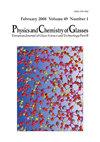碱硼酸玻璃在低改进剂负荷下玻璃化转变宽度趋势的异常
IF 0.6
4区 材料科学
Q4 CHEMISTRY, PHYSICAL
Physics and Chemistry of Glasses-European Journal of Glass Science and Technology Part B
Pub Date : 2017-10-22
DOI:10.13036/17533562.58.5.004
引用次数: 3
摘要
以前在科学院进行的研究已经检查了碱硼酸盐玻璃的玻璃过渡宽度(ΔTg)。Munhollon等人和Starkenburg等人发现碱硼酸盐玻璃在低碱含量时玻璃化转变宽度异常。Masao Kodama也研究了这些热性能;玉玉公布的Tg数据显示了一个相同的异常,尽管没有被提及。该异常得到了验证,数据集得到了广泛扩展,更全面地覆盖了成分范围。Tg和Te采用起始定义。ΔTg定义为Te−Tg。本文基于Shakhmatkin等人的玻璃结构热力学模型对该异常进行了描述和解释。Shakhmatkin等人的方法的基础是,玻璃是由各种相关晶体化学计量的结构分组组成的。硼酸盐晶体结构的知识来自Wright等人。有效温度的概念(玻璃结构被冻结的温度)以及约束理论的改进观点也被采用,其中使用的化学分组是上层建筑单元,而不是短程结构。我们使用上部构造分组,而不是Mauro等人提出的短程三角形和四面体硼,因为在这个组成范围内,任何碱硼酸盐系列之间的短程单元的丰度没有差异。本文章由计算机程序翻译,如有差异,请以英文原文为准。
An anomaly in the glass transition width trends of alkali borate glasses at low modifier loadings
Previous studies conducted at Coe College have examined the glass transition width (ΔTg) among alkali borate glasses. Munhollon et al and Starkenburg et al discovered anomalies in the widths of the glass transition of alkali borate glasses at low alkali contents. Masao Kodama has also studied these thermal properties; Kodama’s published Tg data exhibit an identical, albeit unmentioned, anomaly. The anomaly has been verified, and the dataset widely expanded to more fully cover the compositional range. Onset definitions were used for Tg and Te. ΔTg is defined as Te−Tg. This study describes the anomaly and provides an explanation based on Shakhmatkin et al’s thermodynamic model of glass structure. The basis of the Shakhmatkin et al’s approach is that the glass is composed of structural groupings from various associated crystalline stoichiometries. Knowledge of borate crystal structures were taken from Wright et al. The concept of the fictive temperature (the temperature at which the glass structure is frozen in) along with a modified view of constraint theory was also employed in which the chemical groupings used were the superstructural units rather than the short range structures. We use the superstructural groupings rather than the short range trigonal and tetrahedral borons proposed by Mauro et al since there is no difference in the abundances of the short range units between any of the alkali borate series in this range of composition.
求助全文
通过发布文献求助,成功后即可免费获取论文全文。
去求助
来源期刊

CiteScore
0.70
自引率
33.30%
发文量
0
审稿时长
1 months
期刊介绍:
Physics and Chemistry of Glasses accepts papers of a more purely scientific interest concerned with glasses and their structure or properties. Thus the subject of a paper will normally determine the journal in which it will be published.
 求助内容:
求助内容: 应助结果提醒方式:
应助结果提醒方式:


